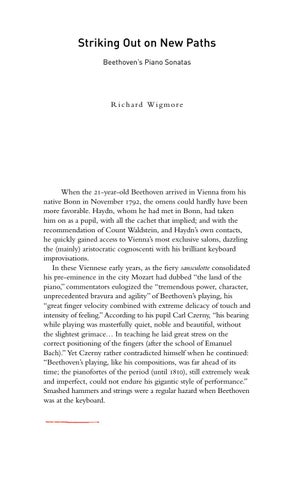Striking Out on New Paths Beethoven’s Piano Sonatas
Richard Wigmore
When the 21-year-old Beethoven arrived in Vienna from his native Bonn in November 1792, the omens could hardly have been more favorable. Haydn, whom he had met in Bonn, had taken him on as a pupil, with all the cachet that implied; and with the recommendation of Count Waldstein, and Haydn’s own contacts, he quickly gained access to Vienna’s most exclusive salons, dazzling the (mainly) aristocratic cognoscenti with his brilliant keyboard improvisations. In these Viennese early years, as the fiery sansculotte consolidated his pre-eminence in the city Mozart had dubbed “the land of the piano,” commentators eulogized the “tremendous power, character, unprecedented bravura and agility” of Beethoven’s playing, his “great finger velocity combined with extreme delicacy of touch and intensity of feeling.” According to his pupil Carl Czerny, “his bearing while playing was masterfully quiet, noble and beautiful, without the slightest grimace… In teaching he laid great stress on the correct positioning of the fingers (after the school of Emanuel Bach).” Yet Czerny rather contradicted himself when he continued: “Beethoven’s playing, like his compositions, was far ahead of its time; the pianofortes of the period (until 1810), still extremely weak and imperfect, could not endure his gigantic style of performance.” Smashed hammers and strings were a regular hazard when Beethoven was at the keyboard.


